The Earth is home to over 400 species of sharks and evidence of their existence dates from 450-420 million years ago. It is not at all surprising that humans find these majestic creatures fascinating and are willing to leave all prejudice aside and share the waters with some of the most feared predators known to man. Diving with sharks is one of the most rewarding experiences for any diver and we know exactly where you can find them. Depending on what species you want to bump into, here are the best shark diving destinations in the world.
Where to Dive with Hammerhead Sharks
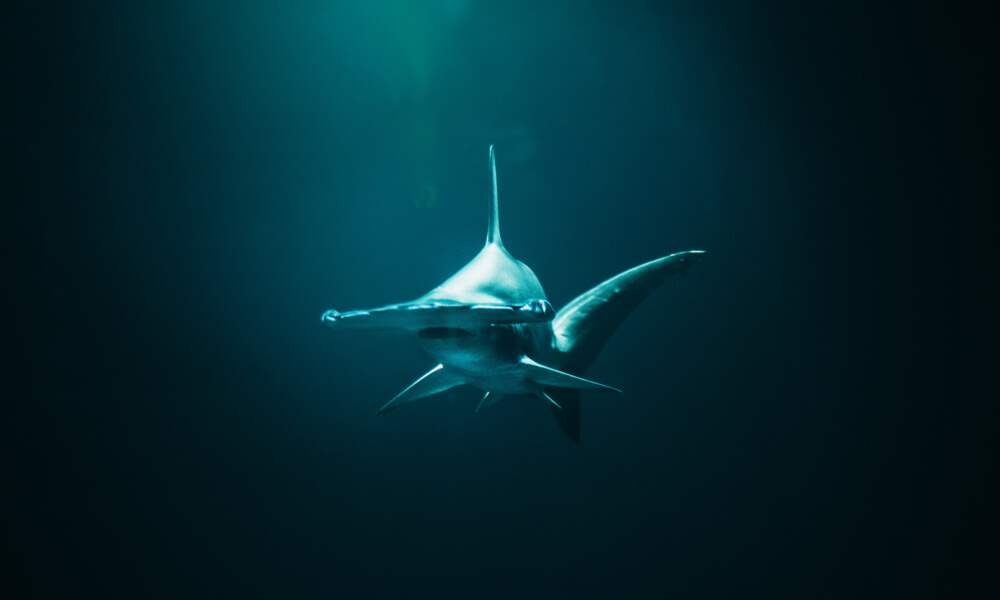
Galapagos Islands, Ecuador
Where: Around the islands of Darwin and Wolf. Kicker Rock and Gordon Rocks are also good spots.
When: Divers can encounter hammerheads all year round, but the largest congregation can be seen in June. A large number of hammerheads remain until November when some start to migrate.
Other sharks: About 30 other species of sharks have been seen around the Galapagos Islands, including whale, horn, whitetip, blacktip, tiger, Port Jackson, and Galapagos sharks.
Hammerhead sharks are one of the most iconic species of sharks and the Galapagos Islands remain one of the best places on Earth to see them. Along with Columbia’s Malpelo Island and Costa Rica’s Cocos Islands, the Galapagos form the Hammerhead Triangle, an area known as the best spot for viewing this species of sharks. Here, divers can spot individual hammerheads, small groups, as well as large schools of up to several hundred. Most species of hammerheads found in the Galapagos Islands are scalloped, but smooth and great hammerheads can also be seen here in smaller numbers.
Malpelo Island, Columbia
Where: El Bajón, La Nevera, and Sahara are some of the dive sites where there’s almost a warranty that you will see at least a few hammerheads on every dive.
When: The best time to visit Malpelo Island and see the hammerheads is January through May.
Other sharks: Galapagos, silky, whale, and smalltooth sand tiger sharks.
This remote island is often dubbed The Shark Capital of the World because of its unique shark population that numbers up to 500 individual hammerheads along with many other species of sharks. The Malpelo Fauna and Flora Marine Sanctuary is a protected marine area and a UNESCO World Heritage Site, but also the largest no-fishing zone in the Eastern Tropical Pacific Ocean. Because of these restrictions, Malpelo Island and its surrounding area have become a “reservoir” for several threatened species of marine animals such as the hammerhead shark.
Cocos Island, Costa Rica
Where: The sharks surround the waters of Cocos Island, but there are a few dive sites that are especially known as hotpots for hammerheads – Bajo Alcyone, Dirty Rock, and Dos Amigos.
When: While for the calmest sea conditions, the best time to visit is during the dry season (December through May), the rainy season (June through November) is viewed as the best season for big pelagics because of the nutrient upwellings that attract a larger number of hammerheads.
Other sharks: Whitetip, Galapagos, tiger, silky, and whale sharks.
Cocos Island is located at the convergence of nutrient-rich currents which makes it one of the best destinations for diving with the big creatures of the oceans. But what the island is most famous for are the schools of hammerhead sharks that can be seen around Cocos Island in vast numbers all year round. Don’t expect to see pretty corals and reefs because there’s not much color in its sloping rocky substrate. Divers come here for the amazing marine life that is rivaled by few other destinations in the world.
Where to Dive with Whale Sharks

Galapagos Islands, Ecuador
Where: In the north of the Galapagos Marine Reserve, around the islands of Darwin and Wolf.
When: There are regular sightings between June and November, but there’s also a very small chance of spotting the whale sharks on the central islands from December to May.
Other sharks: Hammerhead, whitetip, blacktip, tiger, Port Jackson, and Galapagos sharks.
If you’re looking for the ultimate whale shark diving experience, you’ll most likely find it in the Galapagos Islands. The islands are located at the confluence of three oceanic currents and there are numerous areas of upwelling, a natural phenomenon that supports the growth of plankton. And whale sharks love plankton! The Galapagos archipelago also stands out as one of the very few locations where the majority of whale sharks are large pregnant females as opposed to the regular small juvenile males you’d find in many other places.
Isla Mujeres, Mexico
Where: Just off the island, in the open sea.
When: The whale shark season typically starts in late May and lasts until mid-September, peaking from mid-July to mid-August.
Other sharks: Blacktip, bull, gray reef, and nurse sharks.
As one of the largest whale shark aggregation areas in the world, Isla Mujeres is among the best destinations for divers in search of the gentle giants of the sea. Large groups of whale sharks gather here to feed on the delicious plankton and the fish eggs from the spawning little tunny. In fact, there are so many fish eggs that the surface of the water sometimes becomes milky with all the eggs floating on it. While scuba diving is not permitted around Isla Mujeres, you can freedive or snorkel instead.
Ningaloo Reef, Australia
Where: In the Exmouth region.
When: The season typically runs from March to August but may extend until October.
Other sharks: Blacktip and gray reef sharks.
The Ningaloo Coast is famous worldwide for the large populations of whale sharks that aggregate here every year. In fact, it is the only place in Australia where people can participate in whale shark tours to snorkel or freedive with the animals. The sharks appear regularly at Ningaloo triggered by mass spawning of coral and the nutrients coming down from mangrove areas further north. Furthermore, the tropical krill spawn during the whale shark season and their eggs are exceptionally tasty to the sharks, especially in such high concentrations.
Where to Dive with Tiger Sharks
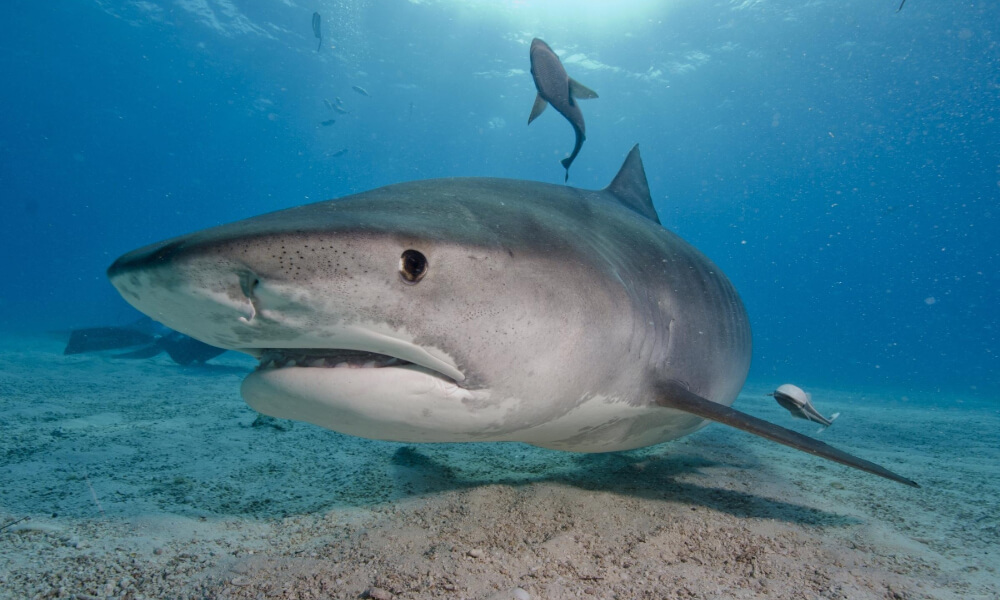
Grand Bahama, Bahamas
Where: Tiger Beach.
When: There are tiger sharks here year-round, but they abound from October and January.
Other sharks: Lemon, reef, bull, hammerhead, and nurse sharks.
It’s hard to believe that the now-famous Tiger Beach was not discovered until the 1980s. Today, this shallow sand flat is one of the most exciting diving destinations on the planet thanks to the variety of species of sharks. Tiger sharks are the main attraction here and may show up in groups larger than a dozen. Plus, as opposed to the remote shark diving destinations, Tiger Beach is easily reachable from the island of Grand Bahama and accessible even to the less experienced divers because of its shallow depth.
Protea Banks, South Africa
Where: Northern Pinnacle
When: From March to June.
Other sharks: Bull (Zambezi), ragged-tooth, hammerhead, and oceanic blacktip sharks.
Diving with sharks at Protea Banks started in the early 1990s and it didn’t take long for the area to be recognized as one of the top tiger and bull shark dives in the world. Diving here is one of the most rewarding experiences, but it’s reserved only to advanced divers due to the depth of the dive sites and the strong currents that are usually present. Baited shark dives are the norm here, with operators using chum to attract the sharks.
Hawaii, United States
Where: Around Oahu’s capital city of Honolulu.
When: July through October
Other sharks: Whitetip, blacktip, hammerhead, Galapagos, gray reef, and sandbar sharks.
Hawaii is known as the tiger shark country, the animals often being found close to the coast of the islands where they sometimes give the surface watersports practitioners a good scare. Diving, however, is one of the safest recreational activities here, as the sharks are not that interested in the bubble-makers. There are also cage dives available for those that may be too intimidated by this feared species of sharks.
Where to Dive with Great White Sharks
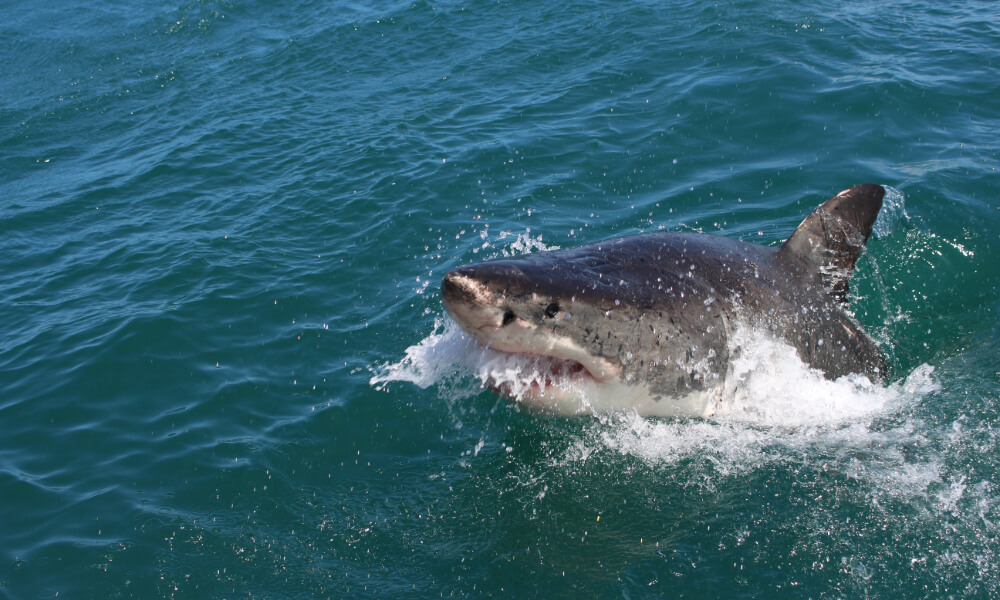
Dyer Island, South Africa
Where: The area between Dyer Island and Geyser Rock.
When: Throughout the year, but the clearest water conditions are from March to September.
Great white sharks are a protected species in South Africa. In fact, it is the first country to give them legal protection. Dyer Island is located along what is aptly dubbed Shark Alley. This is a feeding ground for the great white sharks that feast on the seal pups that, unfortunately for them, feed there too. The region offers excellent sightings of great white shark breaching and predation, and it is now a popular shark cage diving destination.
Guadalupe Island, Mexico
Where: The bay area.
When: Mid-July to mid-November. The beginning of the season brings the juveniles while the big female sharks appear in September.
Self-proclaimed the top destination for great white shark encounters, Guadalupe Island is without a doubt one of the best places in the world where you can go scuba diving with sharks. The crystal-clear waters have definitely added to the island’s appeal. It is estimated that up to 180 individual great white sharks visit the area annually, so encounters are almost guaranteed here on every trip. Chumming or baiting is illegal around Guadalupe Island.
UPDATE: As of 2022, Guadalupe Island has been closed to tourism operations. It is not yet known when the island will be open again to shark diving.
Neptune Islands, Australia
Where: Main and Action Bays.
When: The main viewing season runs from May to October, but the sharks can be found throughout the year.
Other sharks: Bronze whaler sharks.
The rugged and pristine Neptune Islands are home to Australia’s largest colony of fur seals, and guess who loves seals. The seal pups are born in the summer and enter the ocean in the winter, and that’s when the giant great white sharks come to the islands. The Neptune Islands are an internationally significant site for this species of sharks. This is also the only location in Australia where people can get up close to these apex predators and witness the natural predation events.
Where to Dive with Bull Sharks

Fiji, Oceania
Where: Shark Reef Marine Reserve.
When: Between January and October.
Other sharks: Whitetip, blacktip, gray reef, nurse, lemon, silvertip, and tiger sharks.
The Shark Reef Marine Reserve was established in 2004 and it is the first protected sanctuary for sharks in Fiji. The regular shark population comprises eight different species, including the bull shark. In the high season, during shark feeding times, up to 100 bull sharks show up on this site. Bait is used to attract sharks to specific feeding areas.
Playa del Carmen, Mexico
Where: Bull Shark Point
When: From November until January, but they may linger until March.
Other sharks: Whale and nurse sharks.
Every year, dozens of female bull sharks make their way to Playa del Carmen, which is known to be their breeding ground. Bull sharks are drawn here by the freshwater pumped out from the cenotes into the sea along the coast. The bulls are the only species of sharks to support freshwater and have even been observed to go up the rivers in search of food. Playa del Carmen also has a significant sea turtle population, which is among the sharks’ favorite prey.
Bat Islands, Costa Rica
Where: Big Scare
When: Peak season is between the months of May and October, or the rainy season, but the bull sharks are here year-round.
Other sharks: Nurse and whale sharks.
Bat Islands are a world-class dive destination reserved for the advanced divers. The islands are part of the Santa Rosa National Park, a protected area void of humans. This has given the marine life the chance to flourish and divers are guaranteed to see some amazing sea creatures. The biggest draws here are the bull sharks. They are most often found at a dive site known as the Big Scare. Because of the depth of the dive sites, strong currents with surge, and sometimes very low visibility, Bat Islands are suitable for experienced divers.
Where to Dive with Thresher Shark
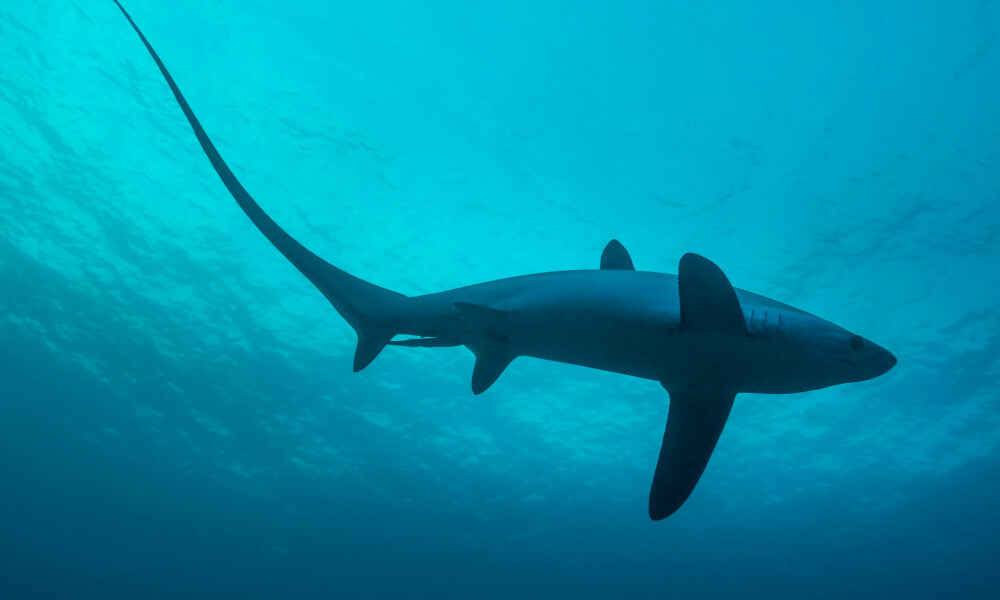
Malapascua Island, Philippines
Where: Monad Shoal
When: Year-round, between sunrise and 9 AM.
Other sharks: Hammerhead, whitetip, whale, bamboo sharks.
Thresher sharks normally live at great depths and are nocturnal creatures, which is why seeing them as a diver is quite a rarity. However, there are a few destinations where they are spotted regularly, and one of them is Malapascua Island. Monad Shoal, an underwater island near Malapascua, is where the thresher sharks come up during the early morning to get groomed by the cleaning wrasses at the cleaning stations. As anywhere else in the world, sightings of thresher sharks are not 100% guaranteed on Malapascua, but they are higher than anywhere else.
Fuvahmulah Atoll, Maldives
Where: The cleaning stations.
When: The sharks are permanent residents, but the best chances of spotting them are between June and December.
Other sharks: tiger, whale, whitetip, hammerhead, silvertip, gray reef
The Fuvahmulah Atoll is one of the best places to scuba dive with sharks because of the diversity of species found here. In fact, Fuvahmulah is one of the only places in the Maldives where you can encounter big pelagics and its flora and fauna are truly unique to the area. But it’s the thresher sharks and the tiger sharks that have made this location famous among divers. The thresher sharks move into the shallows early in the morning or at dusk to visit the cleaning stations on the reef.
Where to Dive with Mako Sharks
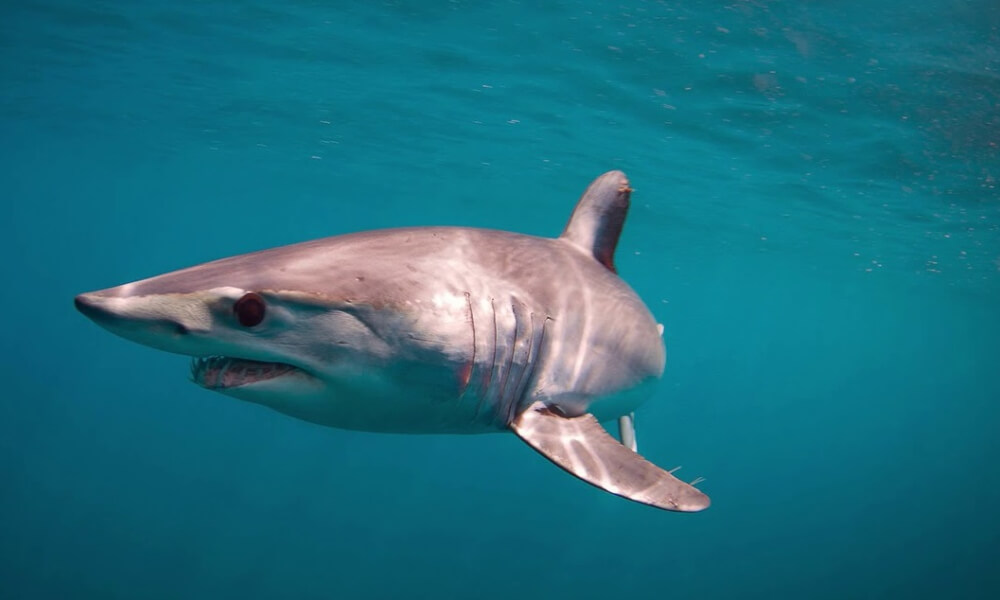
San Diego, USA
Where: Open ocean.
When: June through October.
Other sharks: Hammerhead and blue sharks.
Described by some as miniature great white sharks, mako sharks are the fastest species of sharks, and divers love seeing them in the wild. The population of mako sharks has been rebounding in the last years off the coast of San Diego, where freedivers and snorkelers can join a charter to see these predators. No cages are used on these trips, so it is important to remember that this is an extreme topwater dive with one of the most aggressive species of sharks.
Rhode Island, USA
Where: Open ocean.
When: June through September.
Other sharks: Blue and basking sharks.
Rhode Island, or the Ocean State, is one of the most popular destinations in the United States for diving with sharks because of its populations of blue and mako sharks. Large sharks are out there, but due to the pressures of commercial fishing, the numbers have declined over the years. It’s very likely to see makos with signs of human interactions, as many bear the scars caused by the fishermen. Expeditions to see the makos are cageless open-water encounters where you can only swim, snorkel, or freedive. Bait is used to attract the sharks that may remain close to the boat for hours.
Pico Island, Azores
Where: Open Ocean.
When: Mid-July and mid-October.
Other sharks: Blue sharks.
The Azores is one of the best places to go diving with sharks in Europe and one of the few where you can go scuba diving with the mako shark. The island of Pico is home to the mako shark and the blue shark, and while both species are known to be potentially very dangerous, there have been no registered attacks on dive trips in this region. Those that wish to dive with the mako sharks in the Azores are required to be certified advanced divers with excellent buoyancy control.
Shark Diving Safety Rules
- Educate yourself on their behavior. Whether you want to dive with the more aggressive species or the shyer ones, you should always research the specific behavior of the shark. While not all sharks give out signals before they attack, you can typically tell when a shark is stressed and may act out their distress. For example, fast bursts of speed, jerky moves, and side-to-side head movements are usually signs of an incoming attack.
- Get in and out quietly. When entering and exiting the water, make as little noise as possible. It is also recommended to avoid spending unnecessary time at the surface because that’s where many of their prey like to swim. It’s a known fact that humans are often mistaken for seals.
- Keep still. During the dive, try to remain calm and avoid moving too much, as this may be triggering to the animal. It is advised to stay near the bottom of the ocean and close to the reef wall, if present. Flash photography should also be avoided regardless of how still you remain.
- Don’t approach them. As tempting as it may be too get up close to a shark, don’t try to approach it, especially not from behind. Touch, riding or any attempts to interact with the animal should be off-limits.
- Avoid staring directly at the shark. The animals seem to dislike being looked straight in the eyes, so try to observe them in a less obvious manner.
- Don’t stay too close to their prey. It’s nothing but common sense not to come between sharks and their prey, because it may result in some collateral victims.
- Avoid diving at dusk or dawn. In situations where there are chances of seeing the animals during other times of the day, avoid getting in the water with them at dusk or dawn. Many species of sharks are crepuscular and they can get into a feeding frenzy that may cause them to become aggressive.

Keith Towles says:
I’ve never seen a a shark while diving and have had reservations about being in the water with these magnificent creatures. But information on, the ‘do’s and don’ts of shark dive safety; have made me less apprehensive about being in with them.
Thank you
Stephen Bowers says:
Go for it there is nothing to worry about